Slow Cognition: Three Paths of Creative Life and A Semiotic System

Develop a Curated framework for the Life Strategy project
In the past several months I developed several frameworks for creative life development from different theoretical perspectives. Today I’d like to make a curated framework by connecting them together. See the diagram below.
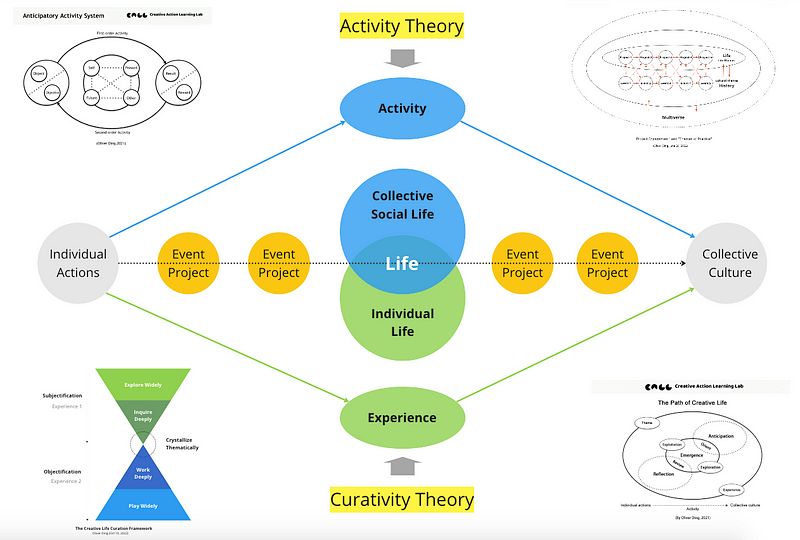
The above diagram highlights three theoretical approaches:
- Activity Theory
- Curativity Theory
- The Project Engagement approach
It also shows the following four frameworks:
- The Anticipatory Activity System (AAS) framework
- The Life—History Complex
- The Creative Life Curation framework
- The Path of Creative Life
This article will unpack these ideas and offer more details about the curated framework.
1. The Path of Creative Life
My primary interest is located in the intersection between Knowledge, Creativity, and Adult Development. I roughly use Creative Life to name this focus.
It’s clear that I don’t want to develop a general framework about adult development for everyone. I only consider Knowledge Workers and Creators as my target audience.
The diagram below was developed on August 30, 2021. You can find more details in D as Diagramming: The Path of Creative Life.

Honestly, I didn’t pay attention to the above diagram too much last year because I was busy developing the Life-as-Project approach which belongs to the field of Activity Theory.
However, I re-discovered the value of the above diagram recently from other perspectives.
Six months ago, I contact Ping-keung Lui who is a theoretical sociological theorist. Lui aims to build a brand new theoretical sociology as a candidate for the paradigm of sociology. According to Lui, “There are three kinds of theories in sociology, namely, social theory, sociological theory, and theoretical sociology. ”
In the past several months, I read his books and papers and learn about his approach to theoretical sociology. Finally, I realized that the above Creative Life diagram echoes his approach. You can find more details about Ping Keung Lui’s idea in this blog post: Re-learning Activity Theory.
In 2007, Lui published a book titled Gaze, Action, and the Social World in which he presented his account of theoretical sociology. The fundamental starting point of his approach is an Ontology of action, which was inspired by Saint Augustine (354–430), Martin Heidegger (1889–1976), and Maurice Merleau-Ponty (1908–1961). See the statement below:
The body is in action, action is in the fleeting moment, the fleeting moment is in the body.
According to Lui, “This moment is Augustinian, it comprises at the same time the Present of the Past, the Present of the Present, and the Present of the Future. The actor Remembers in the present of the past, Pays Attention in the present of the present, Expects in the present of the future.” (p.235–236, 2010, The Scientific Project of Sociology)
Now we can look at the Path of Creative Life diagram again. I realized that the diagram is similar to Lui’s notion of the fleeting moment.
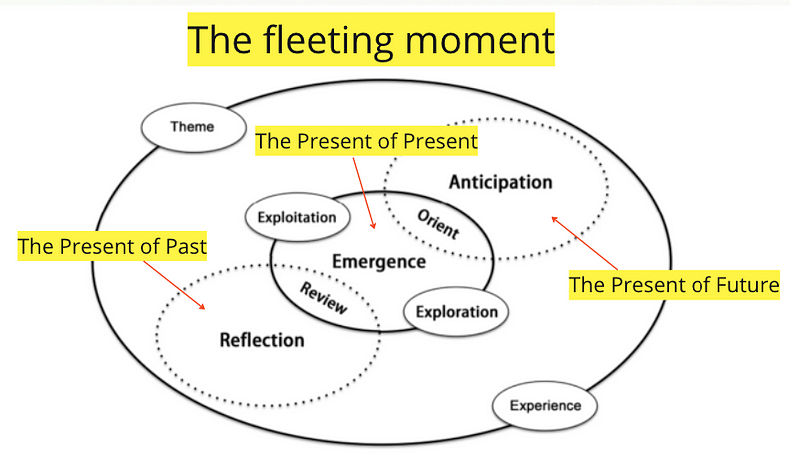
- Reflection: Remembers in the present of the past
- Emergence: Pays Attention in the present of the present
- Anticipation: Expects in the present of the future
The connection between the Path of Creative Life and Lui’s ontology of action encouraged me to rethink the value of the path of creative life.
I realized that I can use it as the ontology of life strategy project. Moreover, I can use Lui’s approach as a frame to curate my frameworks as a meaningful whole.
2. A Significant Aspect of Creative Life
As mentioned above, my focus is knowledge workers and creators. Though there are many important aspects of creative life, I selected the transformation between Individual Actions and Collective Culture as a significant aspect of Creative Life.

Originally, I only considered “Activity” as the mediation of the transformation in 2021. However, I realized that this is one path of creative life. If we adopt more theoretical perspectives, we can find more paths to the creative life.
2.1 Path 1 — Activity Theory
Path 1 is inspired by Activity Theory. According to Activity Theory, the meaning of individual actions is found in collective activities which refer to social practices. In other words, the transformation between Individual actions and Collective Culture is located in Activity.
Moreover, some activity theorists emphasize the impact of contradictions inside activities and consider contradictions as the source of the development of activities. In this way, the development of collective culture is the transformation of activities by solving contradictions. If Individual Actions contribute to the process of solving contradictions, then they contribute to the development of collective culture too.
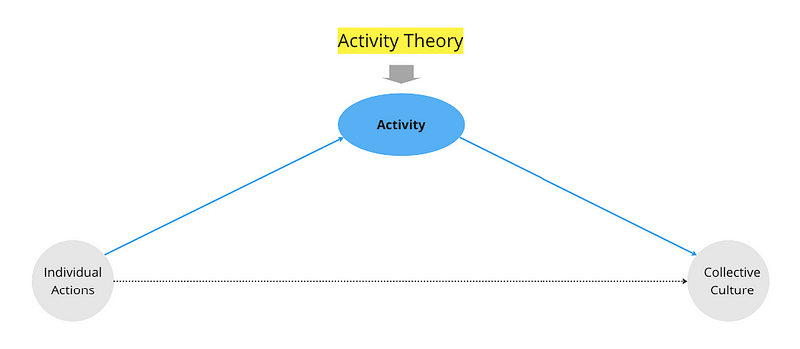
2.2 Path 2 — Curativity Theory
Path 2 is inspired by Curativity Theory which is inspired by Ecological Psychology and other theoretical resources. The term “Curativity” means turning pieces into a meaningful whole. For the present discussion, Individual Actions refer to Pieces while Collective Culture means the meaningful whole.
Curativity Theory considers the Experience of Individual Actions as development resources that can be transformed into Collective Culture. The key to the process of transformation is discovering the match between individual life themes and collective cultural themes.

Path 1 and Path 2 offer two different paths to the transformation between individual actions and collective culture. While Activity Theory pays attention to Activity and Contradictions, Curativity Theory emphasizes Experience and Themes.
2.3 Path 3 — Project Engagement
Path 3 refers to the Project Engagement approach and its application: the Life-as-Project framework. In fact, the approach can be seen as a bridge between Activity Theory and Curativity Theory.

The root of the Project Engagement approach is Project-oriented Activity Theory which is a new approach to Activity Theory because it considers the following two ideas:
- Project as a unit of analysis of Activity Theory
- Activity as a project of formation of a concept
The field of Activity Theory has many theoretical approaches, the major difference between these approaches is their units of analysis. Some approaches use "Activity System" as a unit of analysis. Project-oriented Activity Theory uses “Project” as its unit of analysis.
Project-oriented Activity Theory also emphasizes the notion of “Activity as a project of formation of a concept”. It echoes the notion of “Themes of Practice” of Curativity Theory.
The Life-as-Project approach also considers both Events and Projects which echo Social Social Life and Individual Life.
For the present discussion, the above three paths can be seen as three Social Theories. I will use Lui’s theoretical sociology as a Reference Frame to curate these three approaches into a meaningful framework.
3. A Grand Theory for Theoretical Curation
The structure of Lui’s theoretical sociology is a nested structure. See the diagram below. According to Lui, “The realism comprises a subjectivist structuralism and an objectivist stock of knowledge, while the hermeneutics is an interpretation and an analysis. Second, I shall present an ontology that nests the realism within its boundaries.” (p.250, 2016, Aspects of Sociological Explanation)

We should see this grand theory as a dialogue between philosophy and sociology because “Ontology” and “hermeneutics” are respectable terms in philosophy, but “realism” — sandwiched between them — is not. Lui emphasizes that Realism is the sociological matter proper (p.251, 2016, Aspects of Sociological Explanation).
It can perhaps be said to be the apple in the scientist’s eye,138 though the term “realism” may sound naïve to the phenomenological ear. It is much closer to “what is” than “what is the meaning of”.
In a certain sense, science is always naïve though not simple. With the freedom of imagination being exercised by the scientist to its fullest, it presupposes in the first instance that there is really a reality out there, at least in the Schutzian sense, that is, the reality is often “taken- for-granted”, “questionable but unquestioned.” The presupposition may be naïve, but its buttresses are not. The sociologist—who should be a scientist more than a philosopher—relies on empirical (or positivistic) investigations to buttress his discipline.
Lui considers the following four realities for the grand theory:
- the Weberian course of action
- the Giddensian course of action
- Social Territory
- Symbolic Universe
The Realism is determined by the Ontology. According to Lui, “I made a distinction between action and its course; that is, action is not a reality but its course is. My justification is based on a fundamental ontology.” (p.251, 2016)
The Realism leads to the Hermeneutics which considers two parts: the actors’ interpretation and the researcher’s analysis.
The whole structure of the grand theory is represented by the following semiotic system.
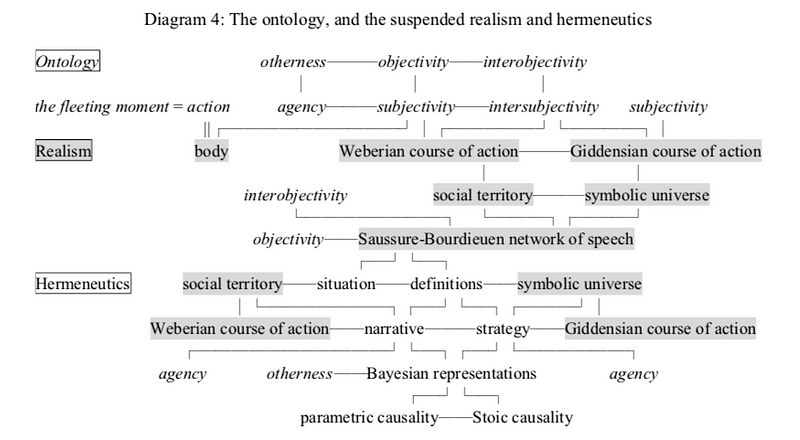
What’s the value of such a complicated grand theory?
Ping-keung Lui aims to build a brand new theoretical sociology as a candidate for the paradigm of sociology. According to Lui, “There are three kinds of theories in sociology, namely, social theory, sociological theory, and theoretical sociology. ”
- Social theories are speculations about the social world. They constitute the speculative project of sociology.
- Some social theories are amenable to positivistic investigation under certain specific conditions. I call them sociological theories.
- Also, some other social theories, being very ambitious, attempt to recruit as many as they can sociological theories supporting themselves. I call them theoretical sociologies. They compete against each other. The winner becomes the paradigm of sociology, and its supporting sociological theories become exemplars of the paradigm. In this way, theoretical sociologies and sociological theories constitute the scientific project of sociology.
In fact, the term “Social theories” refer to all “Social Thoughts”, “Logs”, and “Ideology”, etc. For example, a political party’s ideology and a professional community’s knowledge framework are “Social theories” too. However, Lui only considers Sociological Theories and Theoretical Sociologies as scientific projects.
As a grand theory, Lui’s theoretical sociology can be used as a frame to curate theoretical approaches. For the Life Strategy Project, we can consider it a meta-theory (mTheory) for theoretical curation. The above three paths which refer to three theoretical approaches can be considered Specific Theories (sTheory). See the diagram below.
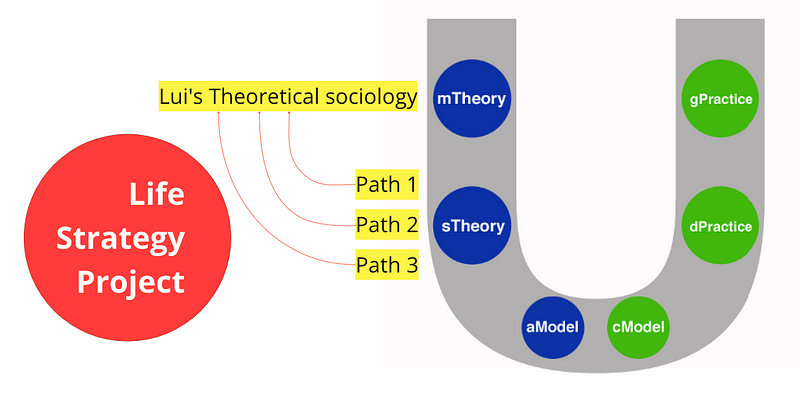
I want to emphasize that the theoretical curation project only aims to make a curated framework for the Life Strategy project. I am not going to integrate the above three theories into one theory. It’s impossible to integrate Activity Theory and Curativity Theory into one theory because they work on different things.
I also want to point out that the new framework is not a direct application of Lui’s theoretical sociology. I only use it as a reference frame for this theoretical curation project.
4. Ontology: The Life-History Complex
The Project Engagement approach (v2.1) has several sub-frameworks. One sub-framework is called Life-History Complex. See the diagram below.
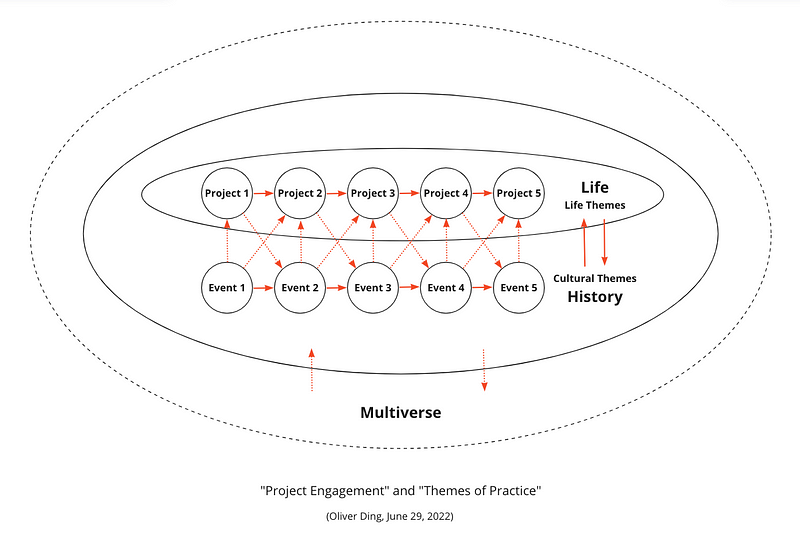
The above diagram is the outcome of a creative thematic dialogue between the notion of “Project Engagement” which is part of Project-oriented Activity Theory and the notion of “Themes of Practice” which is part of Curativity Theory.
It was also inspired by Lui’s grand theory, especially the notion of synchronic and diachronic.
I learned “a mechanism of unfolding” from his meta-theory of theoretical sociology. He doesn’t use the term “a mechanism of unfolding” in his book, but he uses the pair of concepts of “synchronic — diachronic” which is adopted from Ferdinand de Saussure to describe the transformation from micro-immediate situated actions to macro-social structures.
Following his approach, I used “synchronic mapping” to describe the immediate “Event — Project” match. I also used “diachronic unfolding” to describe the development of a chain of Projects and a chain of Events.
While Life is the outcome of the diachronic unfolding of the chain of projects, history is the outcome of the diachronic unfolding of the chain of events.
How to connect the Life-History Complex and the Project Engagement approach in general with the Path of Creative Life?
We can find the answer from Lui’s grand theory again. The diagram below is an expanded ontology of Lui’s approach. (p.22, 2020, Ingold’s Idea of Making — A View from Theoretical Sociology)

Axiom 1 refers to the fundamental ontology of the Action, see the above discussion.
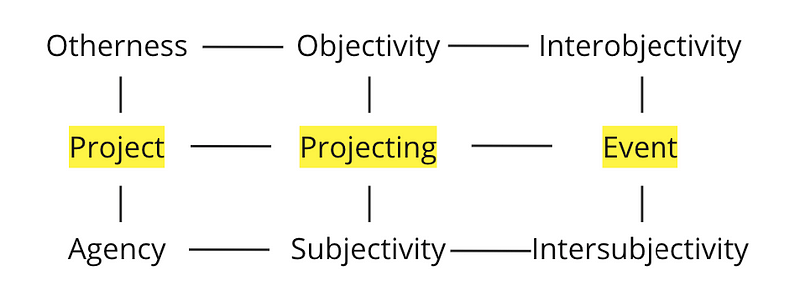
The above diagram is a modified version of the Ontology of Lui’s approach. I used it to highlight the positions of three core concepts of the Project Engagement approach: Project, Projecting, and Event.
Lui defines the concept of Subjectivity as three basic human capacities of the actor: Memory, Attention, and Expectation. We should notice that this definition echoes his fundamental ontology:
This moment is Augustinian, it comprises at the same time the Present of the Past, the Present of the Present, and the Present of the Future. The actor Remembers in the present of the past, Pays Attention in the present of the present, Expects in the present of the future.” (p.235–236, 2010, The Scientific Project of Sociology)
The concept of Agency is defined as all human capacities of the actor other than the basic three, namely, “Memory”, “Attention” and “Expectation”.
The concept of Otherness is defined as the impersonal other. For example, Death. According to Lui, “Otherness as the impersonal other is not a variety of subjectivity. Nor is it a variety of intersubjectivity which by itself is in fact the social process according to George Herbert Mead (1863-1931) in Mind, Self, and Society. Otherness is an impersonal intruder into the social process, most of the time it is called in by some actor, but it belongs to nobody in the social process. This actor exercises his autonomy; he is now more than a simple actor, he is an autonomous actor, an agent. But the otherness he calls in still needs to evade his attention.” (p.242, 2010, The Scientific Project of Sociology)
I consider a mediated layer between Lui’s three pairs of concepts:
- Agency - Project - Otherness
- Subjectivity — Projecting — Objectivity
- Intersubjectivity — Event — Interobjectivity
This notion doesn’t want to modify Lui’s original ontology but offers an idea for connecting the Life-History complex with the Path of Creative Life.
Moreover, Lui’s approach also emphasizes Stoic causality which could support my distinction between Project and Event. According to Lui, “…the Stoic conception that the course of action lives in the depth of the world (the ancient Stoics conceived the world as an ocean) while the corresponding sequence of events (its traces) inheres on the surface. The actor does not bother with the sequence of events, that is, it is out of his memory, attention and expectation, it is ‘dead’, it is therefore an objective reality outside his subjective experience.” (p.247, 2010, The Scientific Project of Sociology)
My approach — the Project Engagement approach — uses “events” and “projects” to present social context and individual biography. The difference between “events” and “projects” is individual involvement. If a person directly gets involved in an activity — it means she is the subject of the activity or part of the community of the activity — then the activity is a project of her biography. If the person doesn’t directly get involved in the activity, then the activity is an event of her biography.
We can adopt Stoic causality for the Project Engagement approach. Projects refer to the depth of the world while Events refer to the surface of the world. Individual involvement changes Stoic causality.
5. Realism: The Anticipatory Activity System (AAS) framework
“Anticipatory Activity System” is a specific theory inspired by Activity Theory, Anticipatory System theory, Relevance theory, etc. It defines the basic model of the AAS framework:
- First-order Activity / Second-order Activity
- The Anticipation — Performance Complexity
- The Self-Other Relevance
The diagram below is the basic model of the Anticipatory Activity System (AAS) framework.

The AAS framework is an abstract model which highlights five movements of Anticipatory Activity System.
- Unfolding
- Discovering
- Modeling
- Producing
- Storytelling / Evaluating
You can find more details in Anticipatory Activity System (AAS) and A Possible Book and The AAS framework for Life Strategy and Service Knowledge Management.
How to connect the AAS framework with the Path of Creative Life?
As mentioned above, the Path of Creative Life echoes Lui’s Ontology. Now we can find a similar echo between the AAS framework and Lui’s Realism.
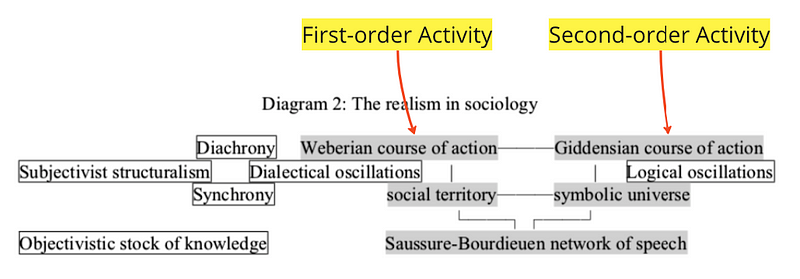
An Anticipatory Activity System is a self-referential system and it has two parts:
- First-order Activity
- Second-order Activity
My original idea about them is that Second-order Activity determines First-order Activity.
I also use First-order Activity to refer to “Work”, “Production”, and “Exploitative Activity”. This notion echoes traditional Activity Theory which is inspired by the Marxist theory of “Work” and “Production”.
Second-order Activity is more about “Play”, “Discovery”, and “Exploratory Activity”. The notion of Second-order Activity goes beyond the scope of the traditional Activity Theory.
Lui’s grand theory doesn’t use “Activity” as a theoretical concept. The basic unit of his approach is “the Course of Action”. According to Lui, there are two types of Course of Action:
- The Weberian course of action: In actual intervention, the actor does not necessarily remember (in the present of the past) nor expect (the present of the future), but he must pay attention (in the present of the present).
- The Giddensian course of action: In contemplation of intervention, however, he does not need to pay attention, though he must remember and/or expect.
These two types of Course of Action are located at the part of Realism in Lui’s approach.
I roughly consider First-order Activity echoes the Weberian course of action while Second-order Activity echoes the Giddensian course of action.
I use the term “echo”, not the word “equal” because I am not claiming that the AAS framework is an application of Lui’s theoretical sociology.
6. Hermeneutics: The Creative Life Curation Framework
In the past three years, I worked on the Knowledge Curation project. After reflecting on the journey, I made the diagram below.

I roughly use five movements to model my journey of the Knowledge Curation project. These five movements form a basic model for understanding Creative Life Curation.
You can find more details in Slow Cognition: The Creative Life Curation Framework.
I also divide the process into two tendencies:
Subjectification
- Experience 1: turning the world into a person’s experience.
- This echoes Second-order Activity.
Objectification
- Experience 2: turning the person’s experience into artifacts for the world.
- This echoes First-order Activity.
These terms link to General Curation Framework and the Anticipatory Activity System (AAS) framework.
The term “Experience 1 / Experience 2” connects to the General Curation Framework. See the diagram below.

As an application of Curativity Theory, the above General Curation Framework represents the structure and dynamics of general curation practice. The activity of general curation aims to collect pieces of things into a meaningful whole in order to present a theme to a group audience.
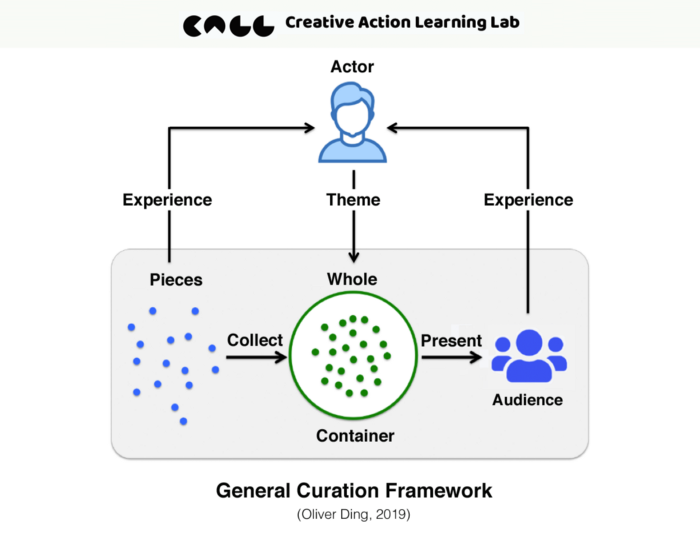
The above diagram highlights several pairs of concepts:
- Pieces v.s. Whole
- Whole v.s. Container
- Collect v.s. Present
- Actor v.s. Audience
- Experience v.s. Theme
I use Experience 1 to refer to turning the world into a person’s experience. For Life Curation Activity, this means Collecting pieces of life experiences.
Experience 2 refers to turning the person’s experience into artifacts for the world. For Life Curation Activity, this means Presenting a new meaningful whole to a group audience.
The key to the transformation between Experience 1 and Experience 2 is Crystallize Thematically which refers to the process of discovering a match between individual life themes and collective cultural themes.
How to connect the Creative Life Curation framework with the Path of Creative Life?
See the diagram below. The notion of “Subjectification” echoes Second-order Activity while the notion of “Objectification” echoes First-order Activity.

If we use Lui’s grand theory as a reference frame, then the Creative Life Curation framework echoes Hermeneutics.

The above diagram is the semiotic system of the hermeneutics of Lui’s approach. This part is quite complex because it aims to deal with issues of social theoretical research.
How to read this semiotic system? Let’s follow Lui’s introduction:
I begin with the actor’s situation, which is the focus of his memory, attention and expectation on the Weberian course of action in which he is participating. It is also the sphere of relevance to him. He sees the situation (in diachrony), and he also speaks about it (in synchrony). The speech he makes is his definition of the situation.
The situation is however not proprietory to him, it is shared by other related actors, although what each sees in not exactly the same. To be exact, we should perhaps take the situation to be the overlaping totality of all the "situations" in the eyes of actors involved. These other actors also speak in the Giddensian course of course about the "situation" they see in the Weberian course of action.
There are more than one definition, namely, the actor’s and the other related actors’. Those definitions are taken from the S-B network (the stock of knowledge, the “library”) by the actors, when they give up their alertness (attention, the present of the present). Equivalently, they are taken from their respective symbolic universes. Again, to be exact, we should perhaps take the symbolic universe to be the overlapping totality of all the “symbolic universes” on the tongues of actors involved. Obviously this overlapping totality is accommodated by the S-B network.
We have seen that “situation” (that is, sight) and “definitions” (sound) in interpretation are suspended respectively by “social territory” and “symbolic universe” from the realism. Next, the actor must deal with his and others’ definitions of the situation, and does it differently in the two courses of action. That is, he is making a narrative in the Weberian course of action, and a strategy in its Giddensian counterpart.
His narrative is, expectedly, suspended by the Weberian course of action (sight) and social territory (sound), that is, he is in dialectical oscillations. Besides being reflexive (he remembers and expects), he is alert (he pays attention). He is overwhelmed by his alertness, he cannot “stop and think”.
If, however, he does stop and think, he will no longer be alert, he shuttles himself from dialectical oscillations to logical oscillations. He in dialectical oscillations is in fact not reflexive (in the literal sense of the word) because his memory and/or expectation do not help him to stop and think, but are simply assisting his attention to respond quickly to others’ definitions. In other words, his definition (narrative) is a quick response to others’. That is why social territory is said to be the S-B network in tension.
His strategy is suspended by the Giddensian course of action and symbolic universe, that is, he is in logical oscillations. The actor is no longer alert, but is reflexive. Without the alertness, he can stop and think. He is in fact asking himself repeatedly this question: “If I define the situation as such, how will the others define it in response?” He is seeking for himself a definition (strategy) in response to which others will define the situation in a way favourable to him. This seeking is an iterative process.
How are narrative and strategy related to each other? They are complementary representations under the aegis of the famous Bayes’s Theorem. In this sense, the collective of Bayesian representations is a method of formal analysis. It is used by the actor implicitly, and can be used by the sociologist explicitly. The implicit use by the former suggests that it is part and partial of the hermeneutics. The explicit use by the latter, on the other hand, enables a distinction of causalities, including the parametric and the Stoic. I shall discuss these two causalities in due course.
Furthermore, like social territory and symbolic universe, narrative and strategy of an agency alternates. But there is a difference: While the former pair alternate as tension-relaxation reversals, the latter pair alternate with a delay effect in the definitions concerned. The situation is like this: when the agency shuttles from strategy to narrative, he carries the definitions made or recognized in strategy into narrative. In fact, the agency makes or recognizes no definitions in narrative, and if he wants to make or recognize definitions, he must return to strategy to do so. On the other hand, since the definitions made or recognized in strategy are carried into narrative, they are subject to dialectical oscillations instead of logical ones.
- Source: Aspects of Sociological Explanation (Ping-keung Lui 2016, pp.255–257)
Lui also develops a Bayesian-based method to explain the complexity of narrative and strategy.
The Creative Life Curation framework represents an extreme case of hermeneutics.
Subjectification
- Experience 1: turning the world into a person’s experience.
- This echoes Second-order Activity.
- This is only about the Actor’s interpretation of her past.
- The Actor doesn’t need to consider others’ definitions.
- The Actor adopts Symbolic Universe as a reference frame for the process of Crystallize Thematically because it refers to discovering a match between individual life themes and collective cultural themes.
- This is all about the Giddensian course of action.
Objectification
- Experience 2: turning the person’s experience into artifacts for the world.
- This echoes First-order Activity.
- This is about the Actor’s interpretation of her present and future.
- The Actor has to consider others’ definitions.
- The Actor adopts Social Territory as a reference frame for the process of making artifacts that deliver value to others.
- This is all about the Weberian course of action.
Why do I claim that this is an extreme case?
Because the Creative Life Curation framework requires a specific time structure. It requires a long duration of Subjectification in order to develop a brand-new theme.
According to Lui, there is a “We-relationship” sequence of the course of action:
When the actor is in the Giddensian course of action, he must be reflexive because he remembers and/or expects. And when he shifts into the Weberian course of action, he is alert because he pays attention. Simply put, he is a cogito in both courses. On the other hand, he for most of the time lives mundanely, that is, he gets by with memory, attention and expectation switched to the lowest possible operating level, if not at the zero level. This is the state which Alfred Schutz (1899–1959) called “We-relationship”. I have incorporated the reflexive state and the mundane state into an alternating sequence as follows:
… I think — We trust — I think — We trust — …
The reflexive state is now further split into two halves, namely, Weberian-reflexive and Giddensian-reflexive. The overall course of action is now a three-state sequence.
While the notion of Subjectification echoes “I think”, the notion of Objectification echoes “We trust”.
For the Creative Life Curation framework, the duration of “I think” is large. It can be several months or several years!
7. A Semiotic System of Creative Life Strategy
The above discussion adopts Lui’s theoretical sociology as a reference frame to curate three paths and four frameworks together. Now we can see the big picture of my ideas about Creative Life Strategy.
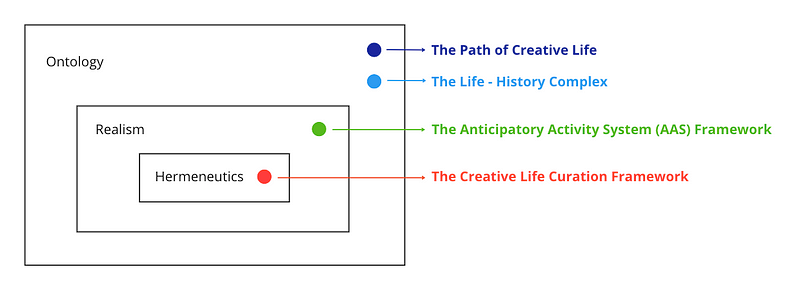
The above diagram uses Lui’s nested structure to connect my four frameworks. It’s clear that these frameworks are located at different layers.
- Ontology: The Path of Creative Life and The Life — History Complex
- Realism: The Anticipatory Activity System (AAS) Framework
- Hermeneutics: The Creative Life Curation Framework
Lui’s approach also offers a brand-new tool called “Semiotic System Diagram” which is a set of concepts that are connected together. He used the same method of mapping the semiotic system of theoretical sociology to map other sociological theories. By comparing different semiotic system diagrams with the semiotic system diagram of theoretical sociology, he can use his theoretical sociology to support and contain many empirical sociological theories.
Lui’s conception of theoretical sociology is presented in the last paragraph of his book Gaze, Action, and the Social World (p.491, 2007).
Theoretical sociologies attempt to understand the fundamental ontology of the social world, its sociological realities and its constitution. Sociological theories attempt to collect exemplars in the social world and therein to analyse its dialectic. Social theories attempt to manufacture various kinds of logos for the social world. By nature they are three different strands of theoretical work, only the first two belong to the scientific [project of] sociology.
Lui’s work focuses on Theoretical sociologies and Sociological theories because these belong to the scientific project of sociology.
From my perspective, Lui’s Semiotic System Diagram and the related method are pretty useful for knowledge creators who are making various kinds of logos as social theories.
Now let’s make a semiotic system for understanding Creative Life Strategy. Since the above diagram shows the basic structure of the map, I collected major concepts from my four frameworks and placed them together.
The final outcome is the following semiotic system diagram.
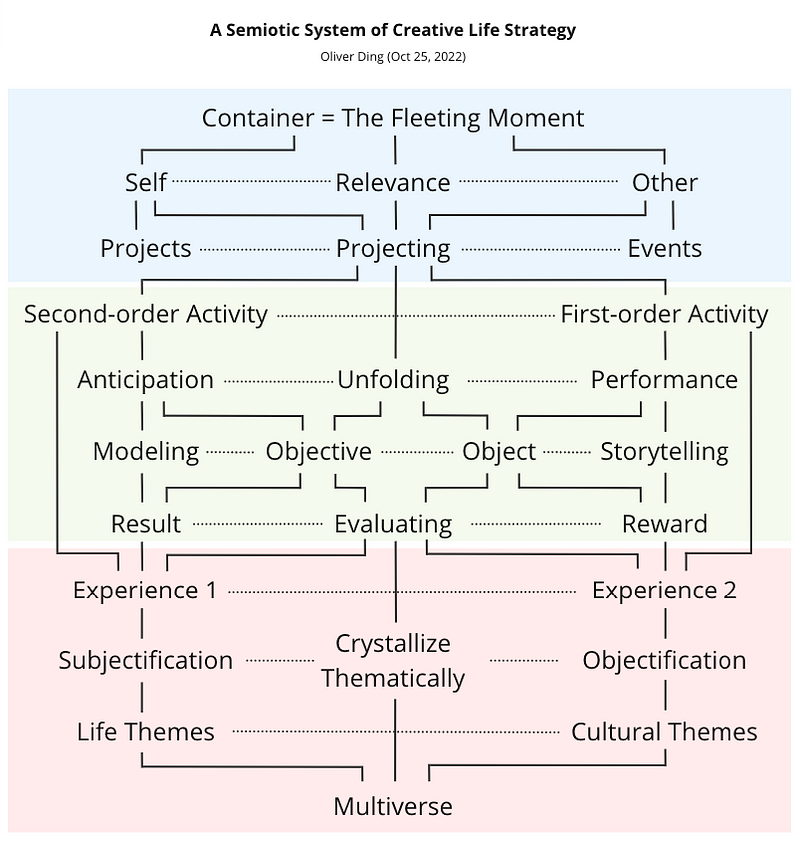
The above diagram uses three colors to highlight three parts of the framework.
- Blue > Ontology: The Path of Creative Life and The Life — History Complex
- Green > Realism: The Anticipatory Activity System (AAS) Framework
- Red > Hermeneutics: The Creative Life Curation Framework
Each part features several concepts from the original frameworks. The whole semiotic system diagram is quite complicated, however, it is not complex and chaotic.
7.1 The Ontology
The first part is Ontology which contains the Path of Creative Life and the Life-History Complex. See the diagram below.

I use “Container = The Fleeting Moment” to refer to the Path of Creative Life. In fact, the concept of “Container” refers to the following diagram which is the basic model of the Ecological Practice approach.
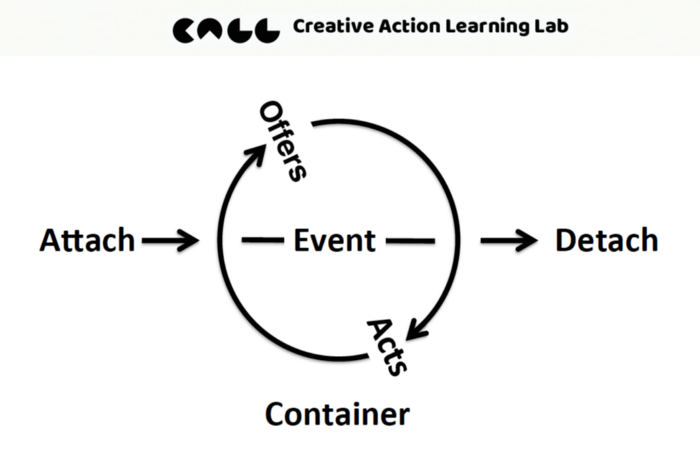
The Path of Creative Life is an application of the above basic model. As mentioned above, the Path of Creative Life considers Reflection, Emergence, and Anticipation, and these notions echo “The Fleeting Moment”:
- Reflection: Remembers in the present of the past
- Emergence: Pays Attention in the present of the present
- Anticipation: Expects in the present of the future
Lui’s Ontology has two levels, the first level is “The Fleeting Moment” which is the foundation of Ontology. The second level contains three pairs of concepts: “Subjectivity — Objectivity”, “Intersubjectivity — Interobjectivity”, and “Agency — Otherness”.
In my semiotic system diagram, the next set of concepts is “Self — Relevance — Other” which echoes Lui’s notion of “ Subjectivity — Intersubjectivity”. While “Self” is only about “Subjectivity”, the “Self — Other” Relevance refers to “Intersubjectivity”.

The above diagram has been discussed. The set of concepts of “Project — Projecting — Event” refers to the Life-History Complex and the Project Engagement approach (v2.1) in general.
The Project Engagement approach (v2.1) is a complicated theoretical framework with several sub-frameworks. You can find more details in Project Engagement (v2.1) as an Innovation Approach. Here I want to highlight the concept of Projecting. See the diagram below.

The above diagram is a model of Cultural Projection Analysis which is a sub-framework of the Project Engagement approach (v2.1). There is a social/cultural environment that contains Events. By perceiving and knowing Events, people recognize the Primary Projectivity which is offered by the social/cultural environments, and initiate a Project. This process is called Primary Projecting.
You can find more details about Secondary Projecting and Tertiary Projecting in Project Engagement (v2): Life, History, and Multiverse.
7.2 Realism
The main content of the Realism of my semiotic system diagram is the Anticipatory Activity System (AAS) Framework. See the diagram below.
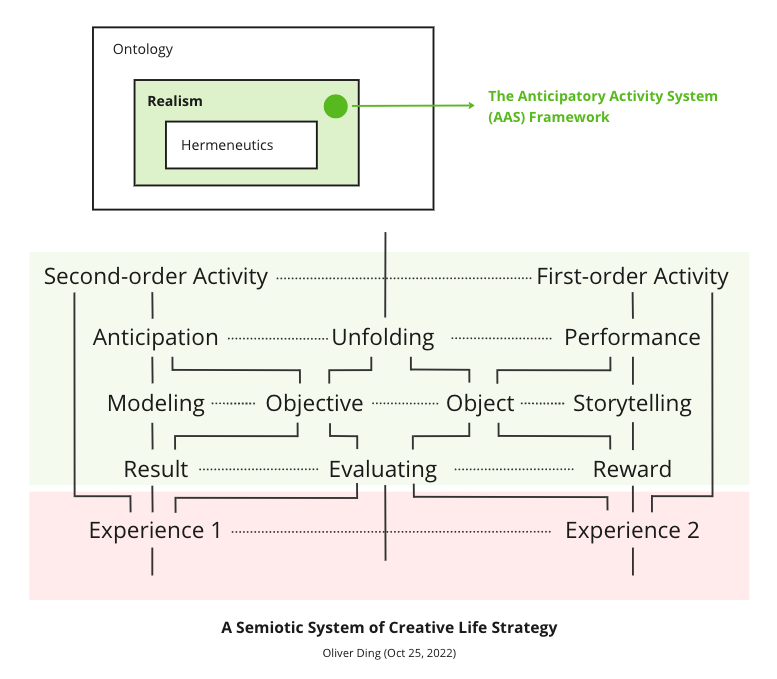
The primary pair of concepts of the AAS framework are First-order Activity and Second-order Activity. As discussed above, while First-order Activity echoes Lui’s notion of “Weberian course of action”, Second-order Activity echoes Lui’s notion of “Giddensian course of action”.
The Anticipatory Activity System (AAS) Framework is a complicated theoretical framework too. I’d like to highlight two of its several sub-frameworks here.
The core of the AAS framework is called iART. See the diagram below. The iART framework considers both the “Self — Other” Relevance and the “Present — Future” Dynamics.
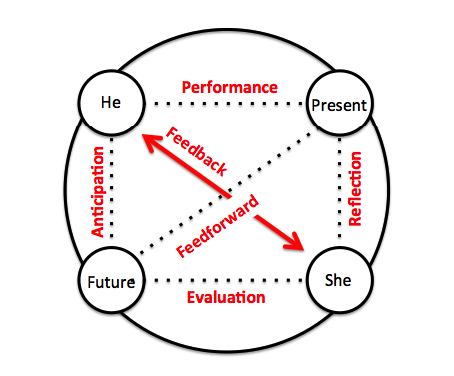
D The actor has an expectation of her ideal life in the future. Let’s call it Anticipation. This anticipation inspires her to make some decisions about her life vision and short life plan which lead to some present actions. This is called Feedforward. Her actions lead to several activities which are perceivable by herself and others. Let’s call it Performance.
After perceiving the performance and talking about it with the actor, Others could evaluate the Actor’s ideal future from their perspectives, let’s call Evaluation. Others could also watch the actor’s daily performances and review these performances from their perspectives, let’s call it Reflection. Others could offer such evaluations and reflections to the actor, let’s call it Feedback.
The “Present — Future” Dynamics are explained in the diagram below.
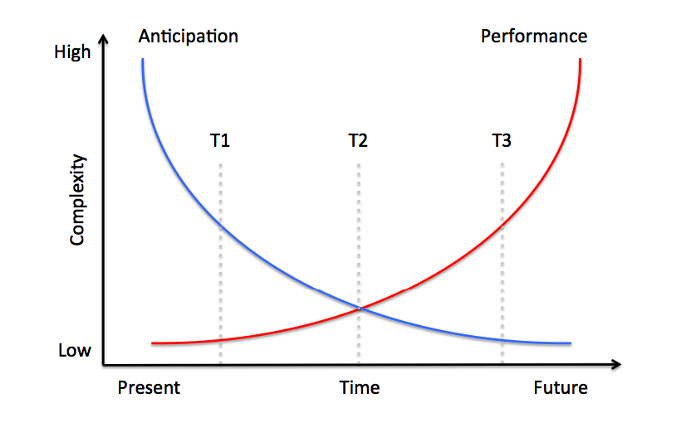
The above diagram is called the “Anticipation — Performance” Complexity.
The above diagram clearly visualizes the dynamics of the AAS framework. At T1 which is an early time point, the complexity of anticipation is high and the complexity of performance is low. At T2 which is a middle time point, the complexity of anticipation reduces to a medium level and the complexity of performance rises to a medium level. At T3 which is a late time point, the complexity of anticipation reduces to a low level and the complexity of performance rises to a high level.
The AAS framework also highlights several significant movements such as Unfolding, Discovering, Producing, Modeling, Storytelling, and Evaluating.
7.3 The Hermeneutics
The third part of my semiotic system diagram is the Creative Life Curation Framework. See the diagram below.
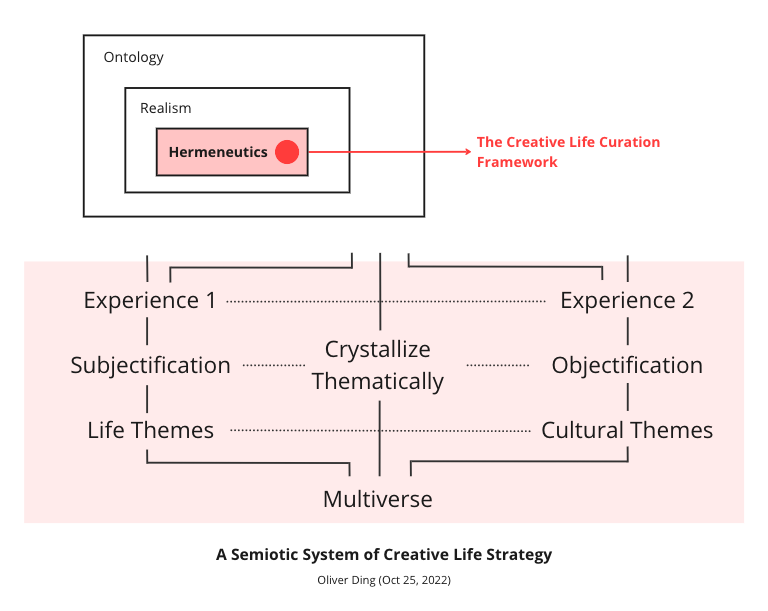
I have offered details about the concepts for this part in the above discussion. Here I want to introduce an important framework called “Themes of Practice” which is part of Curativity Theory.
I consider Themes of Practice as a process type of concept, not a substance type of concept. Thus, it is not a new category of themes, but a transformational process between individual life themes and collective culture themes. It refers to both concept and action. It connects mind and practice. It indicates the transformation of both person and society.
The diagram below is a concrete framework for understanding the “Practice” part of “Themes of Practice”. While a Theme is an abstract idea, we can see it behind several concrete things in the real-life world. You can find more detail in Themes of Practice (2019–2021).
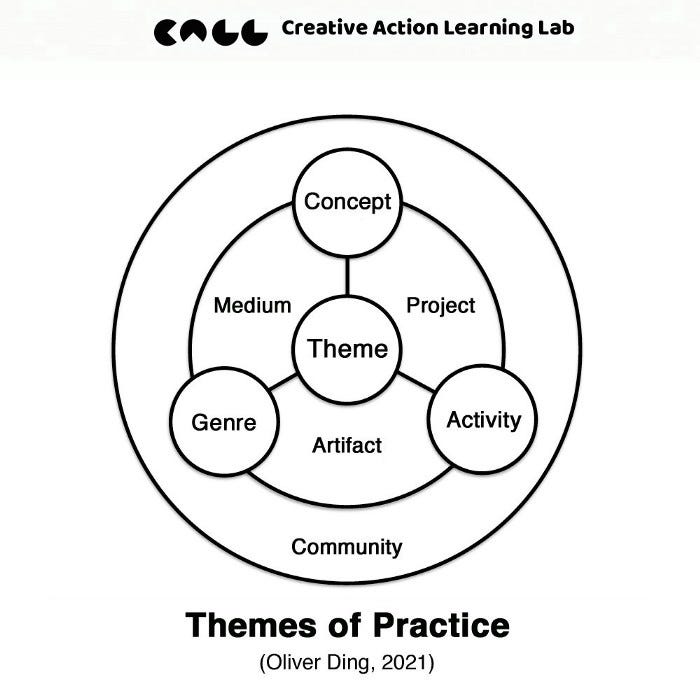
Lui emphasizes the distinction between Actor’s Interpretation and Researcher’s Analysis for the Hermeneutics of his approach. While the Actor only cares about her life, the Researcher aims to produce public knowledge for her scientific projects.
For the Creative Life Curation framework, I emphasize the principle of “Everyone A Curator”. Also, I highlight different types of situations for curating: First-order Curating, Second-order Curating, and Third-order Curating.
- First-order Curating: An Actor is cutting her life experience.
- Second-order Curating: An Actor and a Curator. The Actor’s first-order curating is guided by the Curator.
- Third-order Curating: An Actor, a Curator, and a Meta-curator who guides the Curator. While the Actor and the Curator directly work together. The Meta-curator only directly works with the Curator.
Curativity Theory also has other ideas which can be used for expanding Hermeneutics. You can find more details in Curativity Theory: Table of Contents and Related Articles.
8. Eight Movements of Creative Life Strategy
The AAS framework is an abstract model which highlights five movements of Anticipatory Activity System.
- Unfolding
- Discovering
- Modeling
- Producing
- Storytelling / Evaluating
Now we can find eight movements in the new semiotic system diagram.
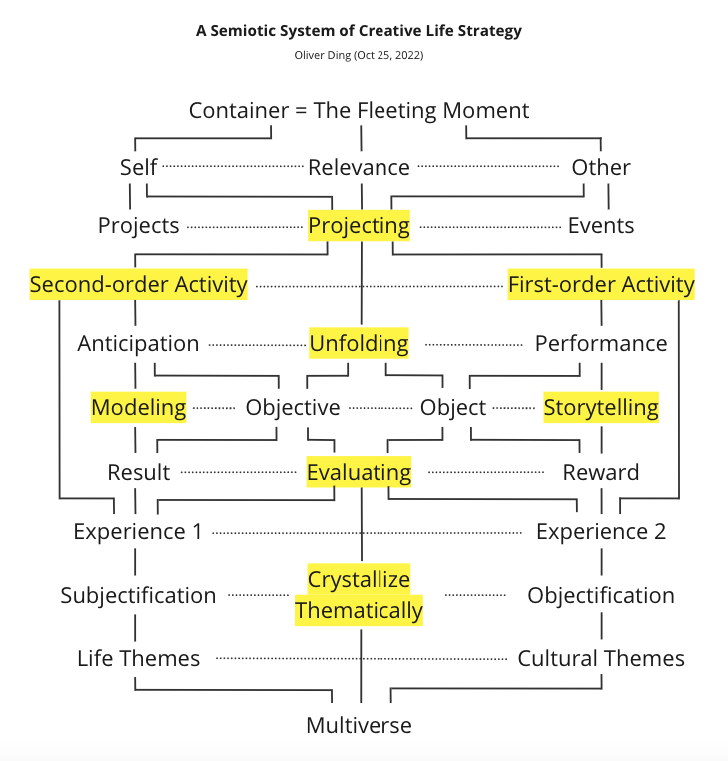
In the following version, I use some red words to translate existing concepts.
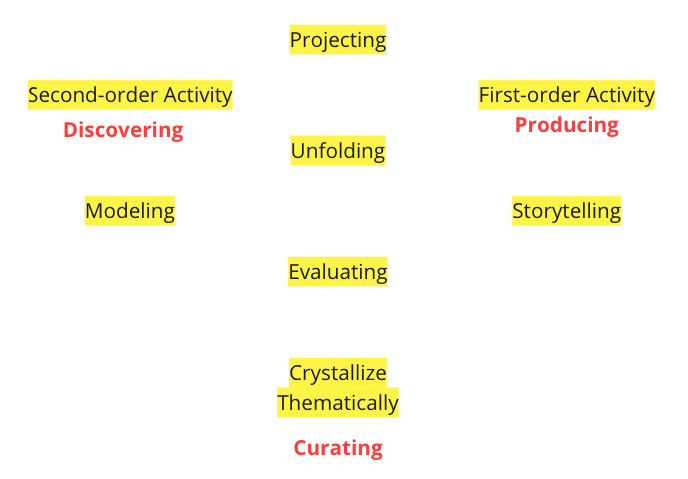
The following words are the final list of eight movements of Creative Life Strategy.
- Projecting
- Unfolding
- Discovering
- Producing
- Modeling
- Storytelling
- Evaluating
- Curating
Why do I use these words to name these movements? Because these words are native vocabulary.
First-order Activity, Second-order Activity, and Crystallize Thematically are theoretical concepts that belong to Controlled Vocabulary.
See the diagram below. Langue and parole is a theoretical linguistic dichotomy distinguished by Ferdinand de Saussure in his Course in General Linguistics. Langue refers to the abstract system of language while parole means concrete speech.

I also developed a typology of Vocabulary to discuss the complexity of these entities.
- There are some themes behind “Action”, but “Action” does directly refer to Vocabulary. Once you use Vocabulary, you start “Discourse”.
- Parole (speech) and Discourse can be understood as the same thing. Both refer to Native Vocabulary and Controlled Vocabulary.
- Langue (language) only refers to Curated Vocabulary.
By using native vocabulary, we can have a simple version of the Creative Life Strategy framework.
This simple version is only a window of the framework.
If we return to Lui’s theoretical sociology, then his theoretical sociology is Langue (language) and he uses Curated Vocabulary to make his semiotic system diagram.
Empirical sociological theories belong to Parole (speech) and their semiotic system diagrams are formed by Controlled Vocabulary or Native Vocabulary.
9. Conclusion
This is a one-day tiny theoretical curation project, but it makes a huge impact on my creative work.
Let’s review the three steps of the creative journey.
On Sept 18, 2022, I designed a cover image for a possible book Knowledge Curation, and used it to close the Knowledge Curation project (phase 1).
Then, I moved to a new journey: the Life Curation project for Life Strategy Center.
On Oct 20, 2022, I reflected on the Knowledge Curation project and published the Creative Life Curation Framework.
Moreover, I used “Subjectification=Experience 1=Second-order Activity” and “Objectification=Experience 2=First-order Activity” which led to a creative dialogue between three theoretical frameworks.
On Oct 25, 2022, I made the diagram below for a theoretical curation project. I wanted to curate three paths and four sub-frameworks together.

While the primary theme is claimed, the concrete solution is not clear. The primary theme is the transformation between individual actions and collective culture.
From three different theoretical approaches, I developed three paths for understanding the primary theme. How can I curate these paths into a meaningful whole?
The above diagram is not the final answer.
I need a new knowledge container to contain these three pieces.
The solution is clear. I can use a meta-theory as the container. Lui’s theoretical sociology is a such meta-theory.

The starting point of this solution is the echo between the Path of Creative Life and Lui’s ontology “The Fleeting Moment”. On Oct 2, I sent an email to Lui and mentioned this insight.
In fact, I mentioned the echo between “First-order Activity / Second-order Activity” and Lui’s realism “Weberian course of action / Giddensian course of action” in an email I sent to Lui on Sep 26, 2022.
On Oct 25, 2022, I realized that the Creative Life Curation framework is located in the Hermeneutics part. Finally, I complete a puzzle.

The final outcome is amazing! What a beautiful semiotic system diagram!
What can we learn from this tiny theoretical curation project?
On Oct 1, 2022, I wrote a short note about a possible book titled Creative Journey: The ECHO Way to Creative Work Study and introduced the ECHO Way (v3.0) model for understanding Creative Cognition. The ECHO Way (v3.0) emphasizes the ecological approach to cognition and applies it to study Creative Thematic Dialogue.
I’d like to use the ECHO Way to explain this story. The ECHO Way is based on a three-container model. See the diagram below.
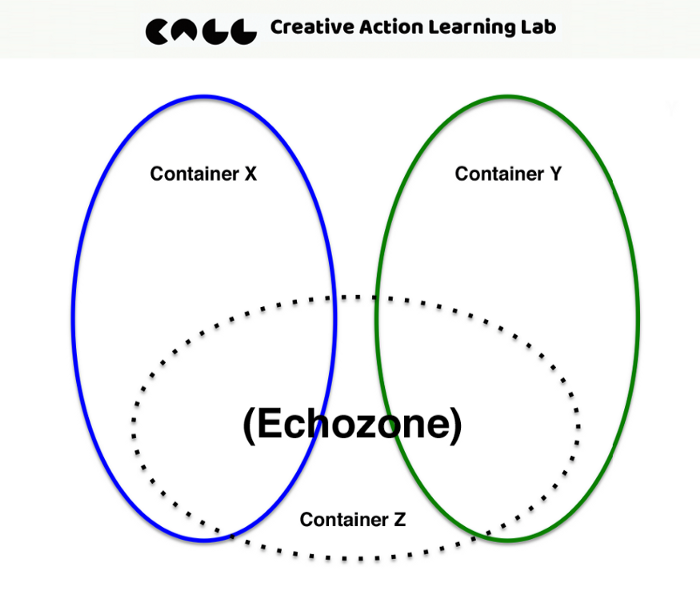
The above diagram is also called WXMY, you can find more details in The Knowledge Curation Toolkit #2: WXMY for Interdisciplinary Curation.
The concept of Container is the core of the Ecological Practice approach. By adjusting the quality and quantity of the Container, we can create advanced frameworks for discussing complex phenomena. The quality of the Container can be potential and actual, and the quantity of the Container can be one or two. If we develop a new framework with one potential container and two actual containers, the outcome is the above diagram.
I named the potential container (Container Z) Echozone which refers to a creative space containing echoes between Container X and Container Y. The term “Echo” of “Echozone” refers to a dialogue between two containers.
How to use the ECHO Way to understand the present story? See the diagram below.
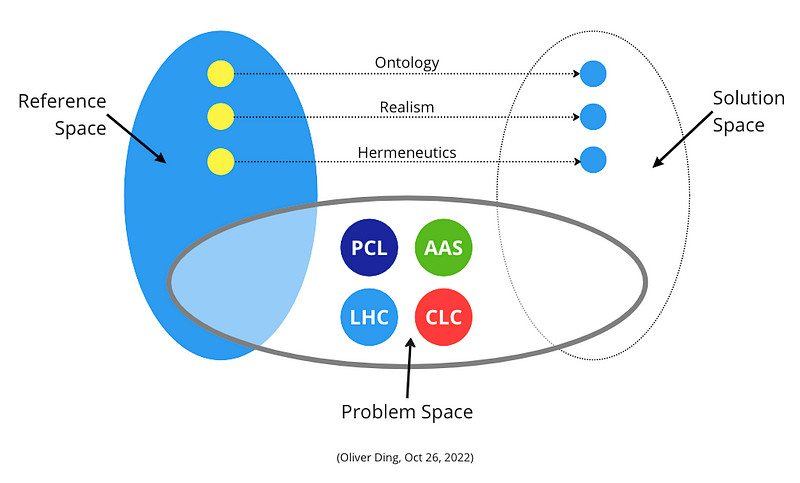
- PCL: The Path of Creative Life
- LHC: The Life—History Complex
- AAS: The Anticipatory Activity System (AAS) Framework
- CLC: The Creative Life Curation Framework
What’s the difference between the above model and the original WXMY diagram?
In the original WXMY diagram, Container Z is potential while Container X and Container Y are actual. The object is using Container Z as a creative space.
For the present case, Container Z is actual while Container Y is potential.
- Container X: Reference Space is actual
- Container Z: Problem Space is actual
- Contaienr Y: Solution Space is potential
How does Reference Space work? It offers the aspect of Form for Solution Space.
How does Problem Space work? It offers the aspect of Content for Solution Space.
How does Solution Space work? It curates Form and Content together.
How did I work with Reference Space and Solution Space?
The problem space was born on Oct 20, 2022. In fact, Solution Space was born before Problem Space. Before working on this theoretical curation project, I was learning Lui’s approach by playing with the semiotic system diagram.
I used a technique called “Deep Analogy” to transfer a Form from Reference Space to Solution Space. The notion of “Deep Analogy” is inspired by Arthur L. Stinchcombe who is a leading practitioner of methodology in sociology and related disciplines. The following quote is found in a note about his 1978 book Theoretical Methods in Social History.
But if general concepts consist in the analogies between elements and if they are deeper if the analogies are deeper, then the basic investigatory task of concept formation is the deepening of analogies.
Far from it being the case that the most powerful general theorists ignore details, the precise opposite is true. Social theory without attention to detail is wind; the classes it invents are vacuous, and nothing interesting follows from the fact that A and B belong to the class; “theoretical” research appears as a species of wordy scholasticism, arranging conceptual angels in sixteen fold ranks on the head of a purely conceptual pin.
But if conceptual profundity depends on the deep building of analogies from one case to another, we are likely to find good theory in exactly the opposite place from where we have been taught to expect it. For it is likely to be those scholars who attempt to give a causal interpretation of a particular case who will be led to penetrate deeper analogies between cases.
While Arthur L. Stinchcombe uses the concept of “Deep Analogy” for theoretical innovation in the field of social sciences, I use the notion of “Deep Analogy” as a technique for turning potential knowledge into actual knowledge.
In other words, while Arthur L. Stinchcombe focuses on public knowledge, I pay attention to developing tacit knowledge from the perspective of individuals. In this manner, I used Lui’s approach as a reference frame for the theoretical curation project.
I have to emphasize that I am talking about a theoretical curation project which can be seen as a problem-solving project. However, my explanation is only about this particular case.
Some thinkers reject Reference Space or Frames for problem-solving projects. This issue is about methods and methodology. It all depends on your situation.
The notion of “Reference Space” and the technique of “Deep Analogy” are really useful for problem-solving projects because we can perceive existing knowledge as our reference frames.
If you have a car, you don’t have to reinvent the wheels.
Lui’s theoretical sociology is a Formula One car.
